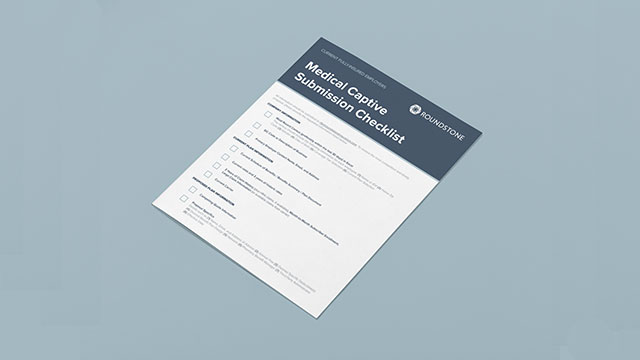Why are MSK Conditions So Costly and What Can You Do About It?
- MSK conditions are costly, requiring multiple tests and treatments and employees taking time off work.
- Roundstone’s MSK “Area to Impact” report details medical costs for the top MSK diagnoses and treatments in your company compared to national benchmarks.
- Data-driven insights help you find ways to save on healthcare costs and redirect them to accessible preventative care, quality providers, and telehealth services.
Healthcare costs associated with musculoskeletal (MSK) conditions can substantially impact your bottom line. As a self-funded employer, you have the flexibility to enact cost containment strategies using data-driven insights that can help save you money while improving the quality of care for your employees.
In this blog, you’ll learn how Roundstone’s data transparency tools and reports can help you effectively manage your MSK costs.
Understand the Costs of Musculoskeletal Conditions
Musculoskeletal (MSK) health relates to the performance and well-being of an individual’s joints, bones, and muscles. Chronic pain and function loss are the primary causes of disability and work loss due to musculoskeletal disorders.
MSK conditions can be caused by a variety of issues, including overuse, traumatic injuries, sprains, bone fractures, and poor posture. MSK conditions are often associated with the workplace. For example, an employee’s MSK condition may occur from overexertion.
MSK conditions are complex and sometimes challenging to diagnose. For instance, diagnosing an MSK disorder may require a wide range of imaging and tests.
The diagnosis and treatment of MSK conditions may vary according to the healthcare provider. Different providers may have different approaches to diagnosing MSK conditions, and some are more likely to recommend surgery than others. These variations mean that treatment, outcomes, and overall expenses associated with MSK conditions can vary wildly.
MSK treatments are often associated with downstream costs for employers and their employees:
| Direct Costs of MSK Conditions | Indirect Costs of MSK Conditions |
| Potential Follow-up Procedures | Missed work |
| Increased Consumption of Opioids | Decreased productivity |
| Potential Surgical Complications | Risk of Layover |
Employers are already bearing these costs. Between 1996 and 2020, treatment for MSK conditions contributed more to increased U.S. healthcare spending than any other category. Employers spend $353 billion annually treating MSK conditions for their employees. In 2018, the American healthcare system spent $420 billion on musculoskeletal (MSK) conditions.
The rising costs of MSK care mean that self-funded employers should expect MSK to remain one of their most significant expenses for their health plans. Roundstone’s CSI Team has built tools to help you understand your health plan’s MSK spending.
Roundstone’s MSK Area to Impact Report provides actionable insights into your MSK spending. Every employee population is different, and Roundstone gives you the tools to help understand yours.
But by utilizing MSK data effectively and adjusting your self-funded insurance plan appropriately, you can better control costs while continuing to offer high-quality care.
Tips for Understanding and Using Your MSK Area To Impact Report in a Self-Funded Plan
Your ATI Report on MSK is key to understanding your plan’s spending on MSK treatment.
Roundstone’s ATI reports use easy-to-read graphs and charts to compare your business’s employee health benefits expenses with national benchmarks to show you how certain conditions impact your health plan and members. Each quarter, Roundstone’s CSI team identifies a theme for the ATI Report by using industry trends and millions of data points to identify a specific area of need.
The following tips will help you get the most out of your MSK ATI Report.
Plan MSK Spending in Context
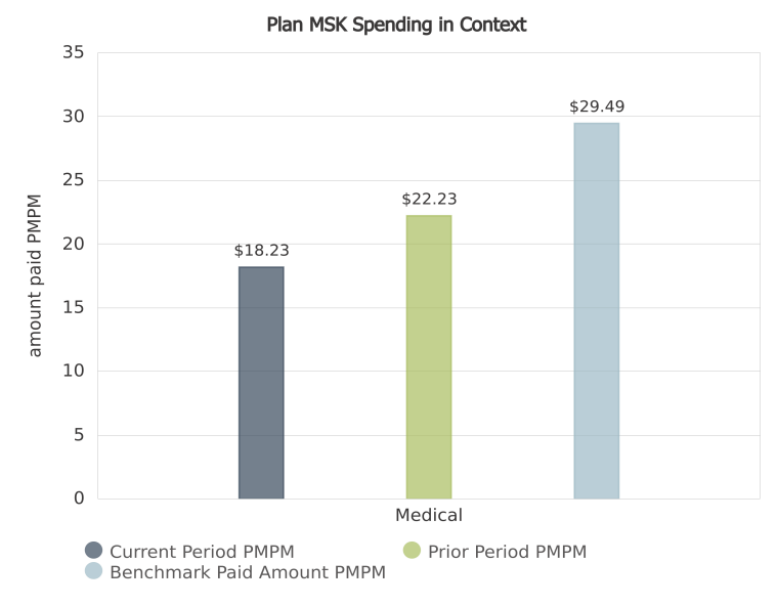
This graph shows how much your plan spends on MSK conditions per month for each member compared to the previous 12-month period. (The last 12 months of your spending might not be available if you’re new to Roundstone or the CSI Dashboard.)
You can compare your plan’s expenses against industry benchmarks, such as how much a group typically spends on MSK per member per month (PMPM).
Roundstone’s CSI Dashboard uses millions of data points to determine the likelihood that groups with similar demographics will perform well. Looking at your expenses against this benchmark spend is an excellent way to identify cost savings opportunities in a self-funded insurance plan.
Number of MSK Claims vs. Total Cost
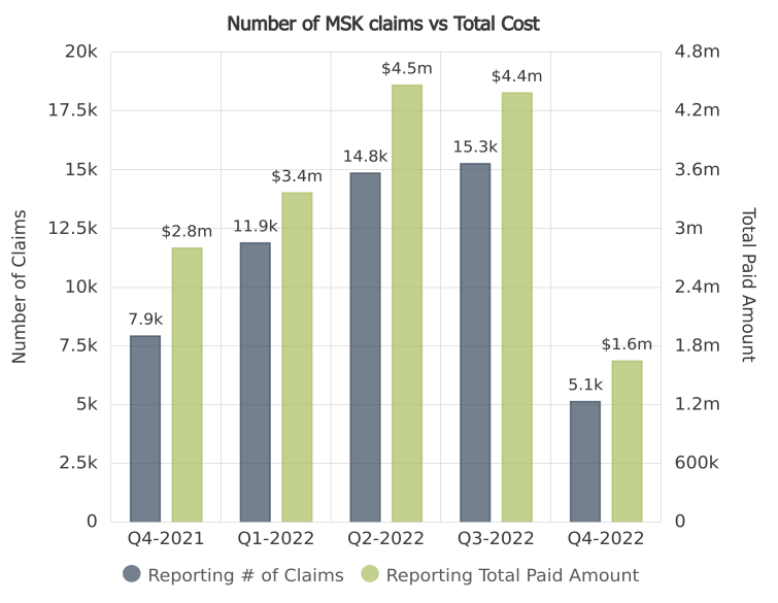
This figure shows the raw number of MSK claims against their cost to your self -funded health insurance plan. Consider whether your MSK costs result from a large number of low-cost MSK claims or a few high-cost MSK claims.
Top 5 MSK Diagnosis
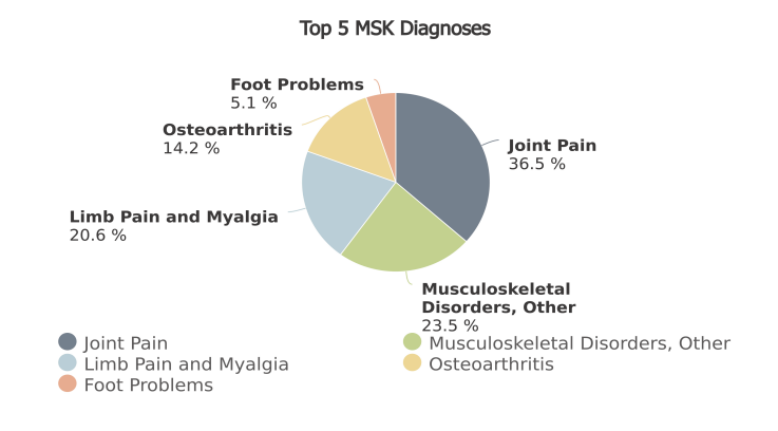
The report shows the prevalence of MSK conditions among employees. In this chart, the most common conditions may not always represent the most significant cost drivers.
Most Expensive MSK Conditions

Use this table to identify the conditions causing your self-funded insurance plan’s MSK expenditures. The table also shows how your employees and their dependents have spent money on these conditions and how that compares with the average monthly spending per member against industry benchmarks.
Relationship Between MSK and Opioid Prescriptions
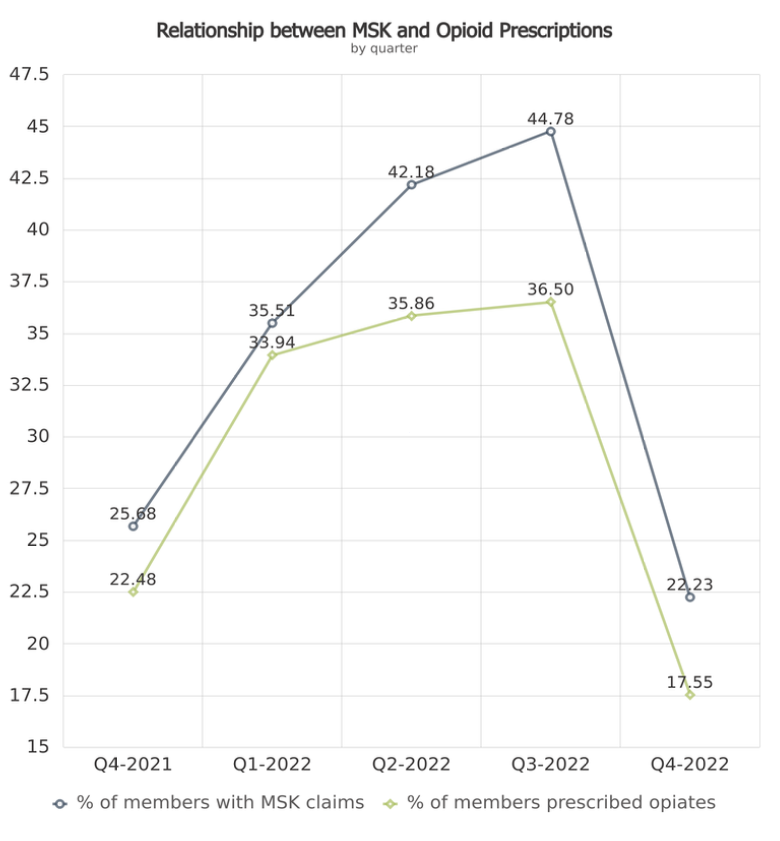
Increased opioid consumption is a common downstream effect of MSK conditions. This chart shows the percentage of your members with MSK conditions and the percentage of members on your plan who have opiate prescriptions.
When viewing this data, note the relationship between the two, and remember that the most recent quarter always shows a downturn because some claims have yet to be filed.

What You Can Do About High MSK Costs? The CSI Solution
Roundstone’s CSI Dashboard provides a visual representation of your medical claims that lets you review your healthcare expenses in real time. Using this solution, you quickly identify areas to offer preventative care and access to quality healthcare providers.
Accessible Preventative Care in a Self-Funded Insurance Plan
The best cure for MSK spending is prevention. Accessible and convenient preventative care is critical to any MSK cost containment strategy. Self-funded employers can incentivize preventive care by eliminating or reducing member costs for preventive services like primary care and physical therapy.
MSK prevention is now easier to access, thanks to recent advancements in telehealth. For example, services like Sword Health allow members to receive physical therapy from the comfort of their homes. Peer-reviewed clinical research has shown online physical therapy is clinically effective and patient-friendly. For example, telerehabilitation improved function and quality of life among patients with osteoarthritis in the knee and low back pain.
Members with limited transportation and time constraints, such as working or caring for children, can more easily take advantage of necessary care with accessible telehealth options.
Better Provider Quality: Knowledge Is Power
Surgical procedures are sometimes necessary to treat MSK diseases. Employers with self-funded plans should direct plan members toward high-quality, cost-effective providers.
Most members choose a surgery provider based on referrals from their primary care physicians (PCPs). Occasionally, PCPs refer patients to others in their professional or personal network. However, a surgeon’s selection does not always consider quality-driven metrics.
Health concierge services such as Rightway help self-funded employers find high-quality, cost-efficient providers in their network using robust provider cost and quality metrics. Members can access high-quality providers through quality-driven provider networks in your plan, like Cigna, to prevent avoidable surgical complications and have the appropriate care for their conditions.
In 2023, Bywater clients will access Sword Health’s telehealth physical therapy options and Rightway’s quality-driven, member-centered care navigation service.

Reduce Employee MSK Benefit Costs with Roundstone
Roundstone’s CSI Team and CSI Dashboard help you implement cost containment strategies to improve your employee self-funded health plan without negatively impacting employee health or your bottom line.
The interactive dashboard and Area to Impact report allow you to find additional savings opportunities and help your employees access quality providers and preventative care for their MSK conditions.
Contact us to discover how Roundstone’s data tools can help your business transform its self-funded insurance plan.

